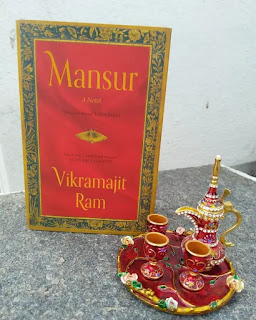Mansur was an early 17th century Mughal nature painter who rose to limelight under the aegis of emperor Jahangir. Known for his realistic paintings of flora & fauna, his mastery earned him the moniker 'Ustad'. His painting of a turkey cock earned him the honor 'Nadir ul-Asr' (meaning Rarity of the Present). His painting of a dodo, made looking at a live specimen, was a sensation when showcased at the International Ornithological Congress at Helsinki in 1958. And it is on 27th Feb, 1627 as Mansur is working on the details of the dodo’s eye in his workroom that this book Mansur by Vikramajit Ram begins.
In the initial chapters, we are acquainted with who’s who as we take a tour of the imperial atelier, the library and women's quarters in Agra. We also learn a little of emperor Jahangir’s family, his equations with his father, children & grandchildren. As the story unfolds, a world of earnest ambition, immense talent & rich imagination is thrown open and we meet other Mughal artists like Abu’l Hasan (the Nadir uz-Zaman/Rarity of the Age), Bichitr (as peculiar as his name). It is a world where one’s creativity earns open reverence and secret spite & envy too.
"From
decades of studying furred and feathered beasts, Mansur has come to understand
that, of the myriad emotions granted to sentient beings, discontent is the
exclusive preserve of humankind."
In prose that moves languorously, that’s as beautiful as nastaliq, we are privy to the closely guarded secrets, fierce competition, misconceptions and petty rivalries among the characters. Mansur’s impending trip with the emperor to Verinag, an important jewel-like verse book whose pages he has decorated with fine art work of butterflies that’s to be presented to the empress Nur Jahan on her 50th birthday are key props that sustain a sense of foreboding.
From a stonecutter’s son to to an orphaned art apprentice to an artist who works on borders during Akbar’s reign to attaining resplendent fame under Jahangir, Mansur’s life journey unfolds delicately like a pencil tracing in this slim read. Bichitr's painting of emperor Jahangir preferring a Sufi shaykh to kings, Abu'l Hasan's portrait of Jahangir shooting the head of Malik Ambar are brought to life in the author's words in this book. An artist's supplies, the different hued pigments in mussel shells described vividly in great detail are a treat to read.
Stories of Mughal kings, their wars & conquests, stories from the Zenena are plenty. But historical fiction that offers a beautiful peek into the lives of venerated painters in the Mughal court is pretty unique, quite like what Mansur’s epithet reflects.

No comments:
Post a Comment